You’re likely reading this blog post because you already know that blogging is essential to your website’s organic search traffic.
And you’re here because you’re now stuck with the question: What do I write about?
With more than 2.5 billion blogs being posted every year, it’s almost impossible to believe that any new blog post could have even the slightest chance of outranking the ones already existing.
There’s just so much blog content already out there, and it’s such a daunting task to figure out how you can stand out.
Fortunately, there are ways to effectively plan your blog content, and we’ve laid everything out in this article — from start to finish. Let’s dive in.
1. Identify your target audience
The first step in creating a successful blog content strategy is identifying your target audience.
Blogging in itself is easy: you put some words together, publish them on your site and Voilà! You have a blog. However, for blog content to really help improve your site’s online visibility, it has to highlight topics that people want to read.
And to create blogs that generate interest, you first need to know who the blog is for.
How to identify your audience
Step 1: Start from the base
Begin the process by making a list of all your company’s services. Identify what kind of problems each of the services are trying to solve and what kinds of businesses are most likely to encounter those problems.
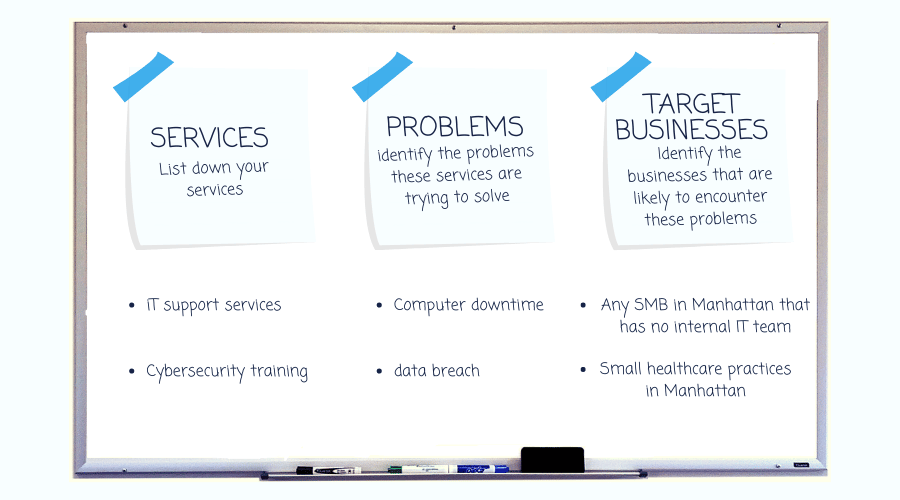
For “Target Businesses”, you can identify specific industries, locations or businesses that use a certain tool. The more specific you are, the better.
If you ever get stuck trying to identify what to put under “Target Businesses”, you can do this process backwards: Get a list of current clients from your support and sales teams and find out what services they are subscribed to.
Step 2: Spy on your competitors
Sometimes, your current client database does not fully represent your market potential. Especially if you’re a growing start-up company, you might be ready to expand your target market into industries you don’t currently serve.
You can conduct a simple competitor analysis to help you decide what kind of new industries or businesses can benefit from your services.
To do this, go to your competitor’s website and check which industries they serve. If they don’t have a section or page on industries served, check their testimonials or Google reviews.
If your services are similar to your competitors’, then chances are, their clients can be yours as well. But be sure to speak to your operations team before deciding to target an industry that you haven’t targeted before.
Step 3: Define a buyer persona
Once you have a list of target businesses, brainstorm with your sales team to identify who would be the main contact person for each of these businesses: What’s their job title? How old are they? What issues are they facing? Why are they contacting your sales team?
Make a list of the most common questions new prospects are asking about.
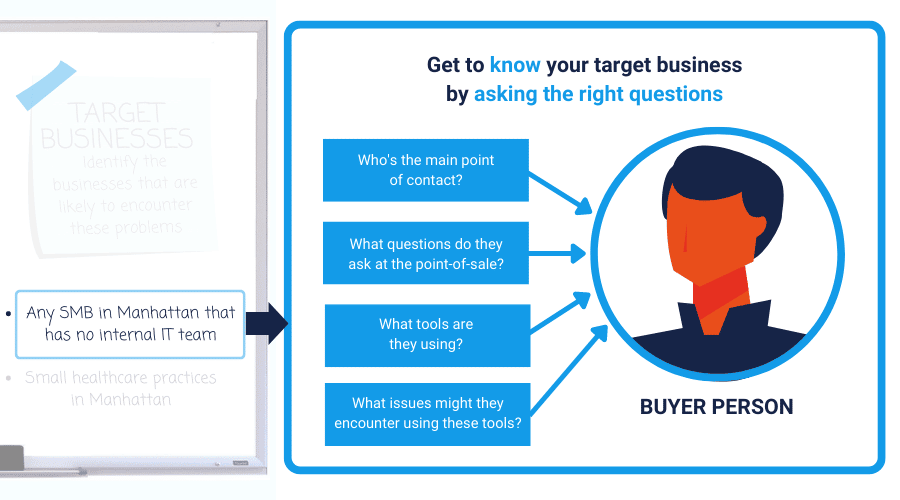
Use the information you gathered to create a buyer persona — a full description of your ideal client. This persona will be useful later when figuring out what topics are interesting to your audience.
2. Understand your audience’s journey
Now that you know who your target reader is, you can now make an inference on what type of content they’d be most interested in. To help you decide on blog post ideas, you first need to fully grasp an important element of blog content planning: your marketing funnel.
If you do an image search for “marketing funnel,” you’ll get a few different variations, from the number of stages the funnel is split into, to the words used to describe each stage. But in any form, a marketing funnel should describe the path that a user needs to take in order to discover your business.
What are the stages of the marketing funnel?
Awareness stage:
Sometimes referred to as the discovery phase, the Awareness stage is where people who are unaware of their need for your services are at — they might not even be aware that your services exist. Thus, your target reader at this stage is unlikely to look up your specific services.
Instead, they might google about their problems or what they perceive to be their problem. As far as they are concerned, all they need is a helpful article and their problem will be solved.
Consideration stage:
Your target reader at this stage of the funnel has knowledge of services and how those can help eliminate the problems they are experiencing.
At this stage, they may be researching whether these services are worth paying for. They may not necessarily be looking at your specific services yet, but instead trying to understand whether or not that service (whether from you or a competitor) will bring them some value.
Decision stage:
At this stage, your target reader needs just one final push into buying in. They’re already aware of the actual problem they need to solve, they know that your services will help eliminate their problem, and now they’re trying to figure out why they should choose you.
People at different stages of the marketing funnel have different interests and states of mind. Understanding each stage of the marketing funnel can help you determine the specific interests of people at varying stages of their journey to discovering your business.
3. Find the right blog topics for each stage of the funnel
To find the right blog topics, you need to identify specific blog content types that match your audience’s interest in each stage of the marketing funnel. Because people in the awareness stage have different questions/problems than people in the consideration and decision stages, the content you should use to attract them to your website should align accordingly.
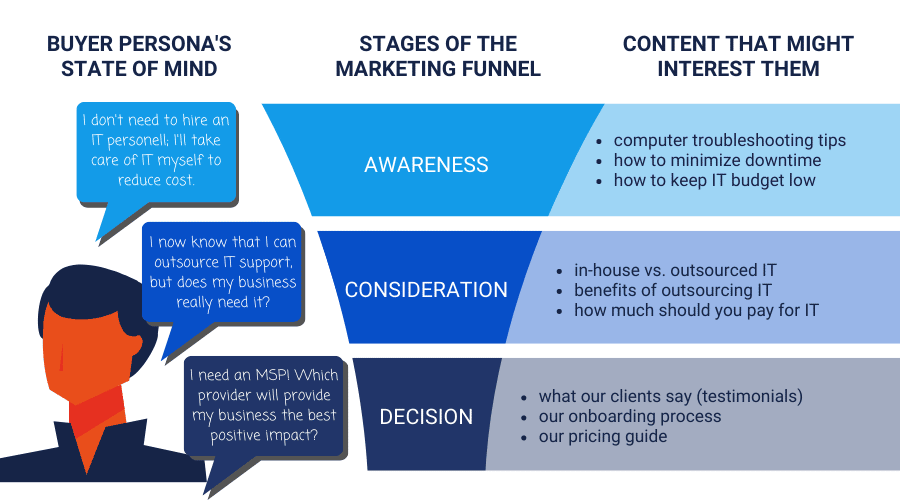
For instance, if your buyer persona at the awareness stage is thinking, “I don’t need to hire an IT personnel; I’ll take care of IT myself to reduce cost” then blog topics like “benefits of outsourcing IT” or “how much should you pay for IT” will not be interesting to them.
To attract them to your site, you need to give them what they need based on their current state of mind. If your writing skills are top-notch, you can use your awareness blog posts to ever so slightly change their state of mind and move them down to the consideration stage, and so on.
Content for the awareness stage
At the top of the marketing funnel, people are still trying to identify their challenges. They might be looking for a solution to a superficial problem, as opposed to the actual problem they should be solving. These “superficial problems” may arise because they haven’t realized their need for your services.
The goal of your content at this stage should be to educate them. Take the following example:
About your business
You are a managed IT services provider which provides full-scale IT support to small start-up businesses.
- Your service: managed IT services
- Problem your service is trying to solve: costly IT issues
- Businesses experiencing this problem (your target audience): any SMB in Manhattan with no internal IT team
Your buyer persona
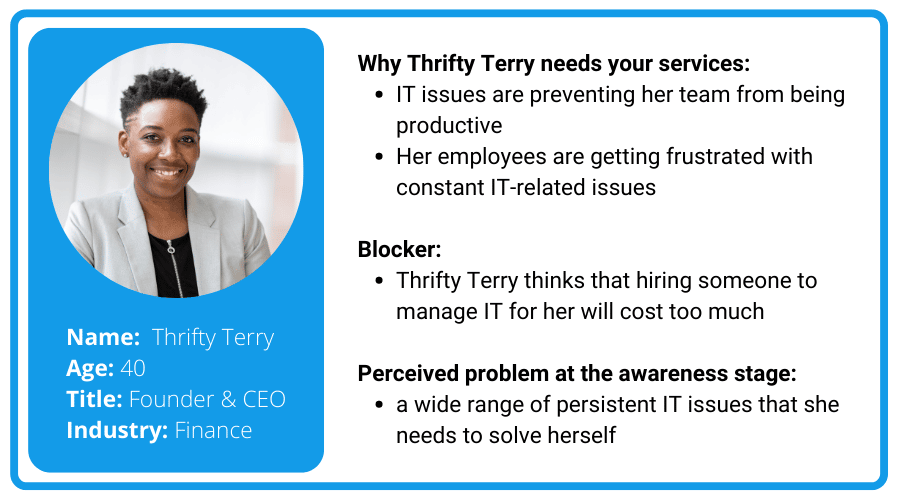
Thrifty Terry, the owner of a small finance firm with five employees is one of the people you target. She is big on saving on costs. Part of her cost-saving strategy is to take care of IT issues that her five employees report.
Her employees are reporting slow computer performance, printer issues, issues accessing their database, issues with using Microsoft Excel, among other things.
Terry is doing her best to provide IT assistance to all her employees by doing a Google search herself to find articles that will help solve the issues raised by her employees. She’s not always able to solve a problem as quickly as she would like to, so her employees sometimes have to wait until she finds a solution.
At the awareness stage, Terry does not recognize the actual problem and instead believes that hiring someone will cost too much. This means that she will probably not find content that encourages her to buy your managed IT services all that interesting.
You may have all sorts of blog content talking about how beneficial a managed IT services provider is in the growth of a business, but Terry at the awareness stage will never be interested in reading them. As far as she’s concerned, your website doesn’t have anything to offer her, and you’ll never be able to move her further down the marketing funnel.
However, if you publish content that helps solve Terry’s perceived problems, then you might have a chance. Because you know that Terry’s perceived problems involve anything related to IT, you know that she will be interested in the following articles:
- Why is your computer so slow?
- 8 most common printer issues and how to fix them
- Top 5 applications that will help keep your employees productive
- 10 Microsoft Excel productivity tips
In the above articles, you will not be trying to sell anything to Thrifty Terry. By having these articles, what you’re doing is enhancing your site’s authority and establishing yourself as a trusted source of useful resources.
To help Thrifty Terry move further down the funnel, you should add small sections in your awareness blog posts that help her depart from her current state of mind.
For example, you know Terry is concerned about costs, so in your educational blog post “8 common printer issues and how to fix them”, don’t just list down all of the printer issues and their corresponding fixes.
Instead, be sure to mention how it could be less costly if she has a dedicated IT provider that takes care of these issues. But make sure not to come in too strong — you don’t want her to lose trust in you by sounding too eager to sell. Remember that your goal is always to offer help.
Content for the consideration & decision stages
At the consideration stage, people are already aware of their actual problem and might already have an idea which services they need. They may not already be considering your specific services, but instead researching whether to go for one type of service or another. Continuing from our earlier example:
Thrifty Terry has realized that she might actually need some help in managing her business’s IT. Budget is still a big issue for her so she’s trying to figure out which is cheaper, hiring an internal IT team or hiring a managed IT services provider.
At this point, content that Terry will be interested in are those that talk about the impact of a service to a business:
- How a managed IT services provider can help you save on costs
- Internal IT vs. outsourced IT: Which one is right for your business?
- Ways that a managed IT services improves employee productivity
- Tell-tale signs that you need managed IT services
Your articles for this stage of the marketing funnel all point to the reason a business should consider hiring a managed IT services provider. What your articles are trying to do is convince her that hiring you is the right way to go.
It’s a great practice to add links to decision-stage content in your consideration articles to help speed up the process of moving your target audience further down the funnel.
For example, in the middle of your article “How a managed IT services provider can help you save on costs,” you can add banner similar to the one below – make sure to link it to the appropriate content:
At the decision stage, people have decided on a specific service and are considering where or from whom to get that service. So your content should be all about convincing them that you’re the right way to go.
Types of content that will be interesting to people at this stage are service pages, case studies, pricing guides, FAQs, and competitive side-by-side feature analyses.
How to generate blog post ideas
Make a list of questions or problems your buyer persona might have at each stage of the funnel.
Remember to consider the tools they are using and the questions they usually ask.
For example, if your buyer persona uses Microsoft Excel, list topic clusters that are related to Microsoft Excel such as “MS Excel how-tos” or “tips on being productive in Excel.“
Once you’ve written your topic clusters, use Google Search (or any search engine) to find websites that create content related to a topic you have listed. You can use the following search term format: [topic cluster] + blog.
For example, you can look up “computer troubleshooting tips blog.” List all of the results that you think will be interesting to your buyer persona.
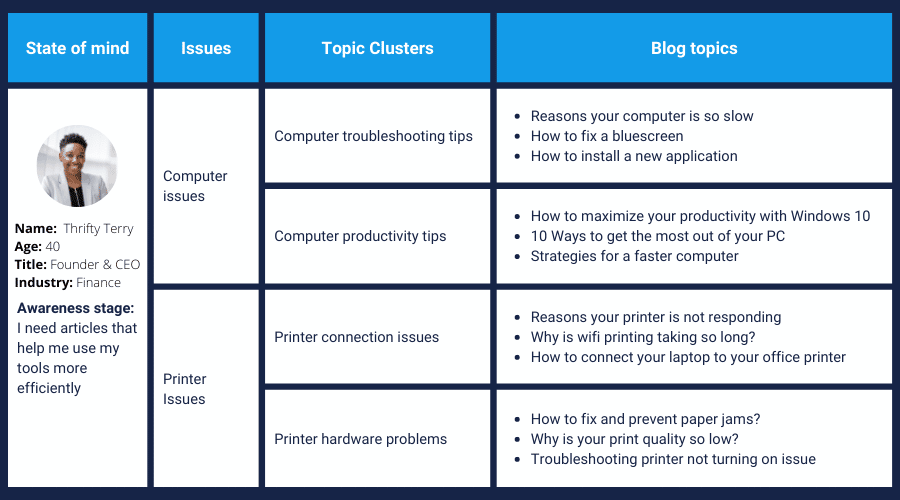
4. Target the right keywords
Simply knowing who to write your blog content for or what blog posts they might be interested in is not enough to create a successful blog content plan.
In fact, blog content strategists and writers are just too familiar with the scenario where they publish what they thought was a really good blog post that their target audience would find interesting only to later see it underperform.
This is very common because writers often overlook the importance of keyword research or just simply fail to understand that keywords are at the heart of generating organic traffic.
But before conducting keyword research, you need to make sure that you understand a key concept of keyword analysis: search intent.
What is search intent?
Search intent is the purpose behind a search query. When a user types a keyword on Google Search, that user is hoping to find something.
Every keyword we use on Google Search represents a search intent. This is how Google is able to match search terms and search results ever so accurately. For instance, if you type in “divorce lawyer,” Google assumes that your intention for looking up this keyword is to find a divorce lawyer so you’ll likely get a list of websites that offer services from a family lawyer.
However, if you type in “what is a divorce lawyer” or “qualities of a good divorce lawyer,” the search intent changes and the search results change with it.
By understanding search intent, you can more easily identify what type of content matches a specific keyword. Your knowledge of search intent can help you guide the way you write a specific blog post.
As an example, let’s consider the keyword “microsoft excel productivity tips.” Based on the keyword alone, we can infer the user’s intention for typing this keyword onto a search engine: to find tips on how to use Microsoft Excel more efficiently. Because we know what the search intent is, we can more easily write an article that provides exactly what the user is looking for.
We also know that we don’t have to bother adding details in our article that don’t match the search intent, like “What is Microsoft Excel” or “Why you need Microsoft Excel.”
Why target specific keywords?
As I’ve mentioned previously, 6 million blog posts are being published every day. And with that big a number, it’s not too hard to believe that multiple articles have been written about the exact same topic. But despite these articles having very similar content, not all of them show up on search results.
Let’s investigate why that is.
When a user types a search term on a search engine, the search engine creates a list of articles that are relevant to that search term and presents that to the user as the search results. Search engines use an algorithm to rank the relevant pages. This algorithm looks at many different factors to decide what the search intent is and what articles are relevant to that search intent.
One of the key factors that search engines look at is the use of certain keywords. If you write an article with a target keyword in mind, you’re increasing the possibility that search engines will consider your article relevant to the user who uses that keyword, and therefore rank your article higher in the search results.
Ranking at the top of the search results is an important goal when blogging. The higher your blog ranks, the higher your chances are at getting more traffic.
Not all keywords are the same. There are two main qualities of a keyword:
- Search volume: the number of times a keyword gets used in a search engine within a given period.
- Competitiveness: as more and more articles are published targeting the same keywords, the competitiveness of that keyword increases. Simply put, competitiveness is the quality of a keyword that describes how difficult it is to rank for it.
These two qualities make it important that you conduct keyword research before writing a blog. They help you identify which keywords are likely to get searched, are easier to rank for, and can bring you more traffic.
How to conduct keyword research
Step 1: Use Search Engines
Go through your list of blog topics and look them up on Google. Look at the first few results to see if this is what you expect your target audience would find useful.
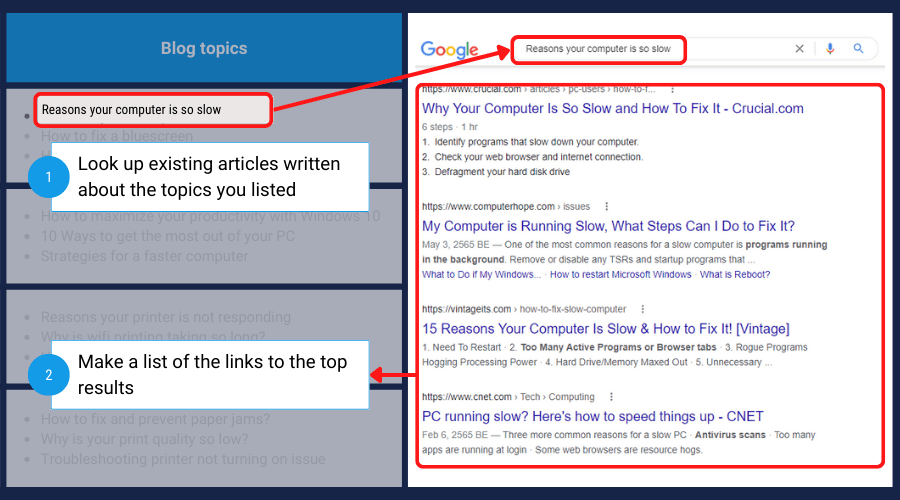
Copy all the links of the top results into a document to keep things organized:

Step 2: Use a keyword research tool
Keyword research tools like Ahrefs allow you to identify what keywords a specific blog is ranking for, and hence what your blog should be targeting.
Copy the link of the top result from step 1 and paste it onto Ahrefs’ link explorer. Make sure that you set the search parameter to “Exact URL” and click the search icon.
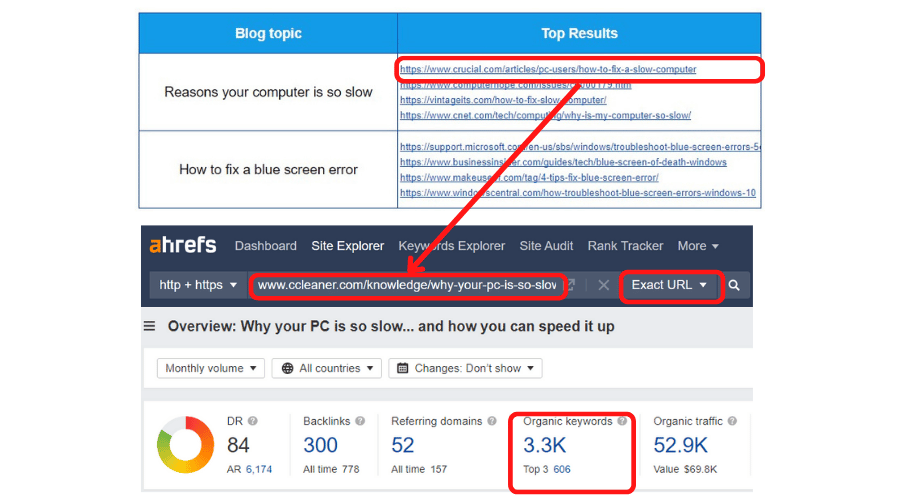
If you click on the “Organic Keywords”, you’ll see a list of keywords that that specific blog is ranking for:
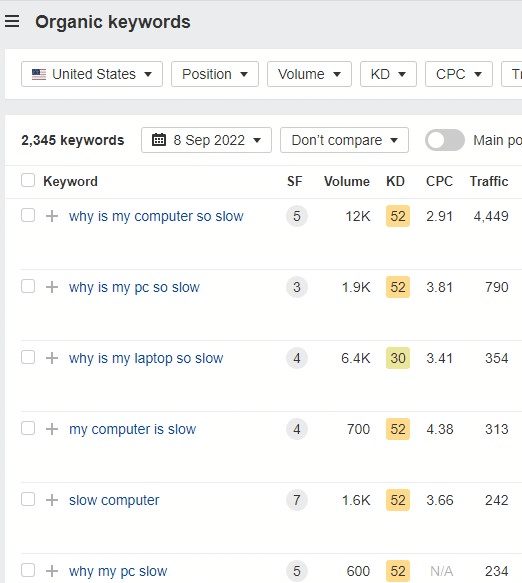
On the organic keywords page, you can set a filter for Keyword Difficulty (KD). KD represents how difficult it would be to rank for a specific keyword, so the higher the number, the more difficult it is. Aim for a difficulty level that’s lower than 20 whenever possible.
Pick keywords with significant search volume but low difficulty. For example, here’s a list of keywords with difficulty of not more than 20 that the sample blog is ranking for:
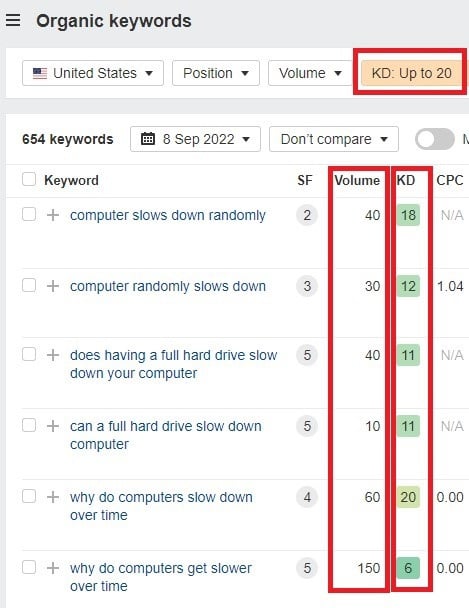
Because we see that the keyword “why do computers get slower over time” gets searched 150 times a month, and it’s not very difficult to rank for, we can add it as a target keyword for our blog.
5. Set up a clear editorial process
Blogging on a regular basis, even with the guidance of a strong content strategy can become messy, especially if you don’t establish a process that everyone involved can abide by.
A surefire way to avoid losing track of your content strategy is creating an editorial process that helps you ensure that all contributing members are productive and accountable to the tasks assigned to them.
Start by creating an editorial calendar. Your editorial calendar needs to be clear on who’s assigned to which task and when each task is due.

Use the editorial calendar to also keep track of what’s already been published, so you know which blog needs to be updated or linked to in newer blog posts.
6. Write with the intention of being helpful
In the previous sections, we’ve identified your target audience, studied their journey through your marketing funnel, identified what topics they are interested in, and what keywords to target with your blog.
You’ve created a buyer persona for a reason: to identify the people who need your services the most. You also went through the rest of the previous steps to find out what blog content your buyer persona will appreciate at different stages of their journey.
The next step in the process is actually writing the blog.
Related article: 8 Effective Blog Writing Tips
Many bloggers make the mistake of writing articles with the goal of selling their services. But you likely won’t make this mistake if you’ve carefully studied the interests of your buyer persona at different stages of the marketing funnel as outlined above.
When you start writing your blog, be sure to always keep your buyer persona in mind and the stage of the funnel where they’d likely find your blog interesting. Remember that Google’s algorithm heavily factors in the search intent, so while you should understand how Google will see your article, it should be written for people first.
And of course, don’t forget about your target keywords. Use content editing tools like SurferSEO which can tell you what keywords to use as well as how frequently and at which parts of your blog they should appear. Here’s a few keyword targeting tips:
- Always use the exact target keyword in the title
- Use the keyword in the URL of the blog
- Use keywords in your meta description
- Use variations of the keyword in the headings and subheadings
- Use keywords in the paragraph tags
Important things to remember
- Never lose sight of your target audience. All your content should be aimed at engaging them, helping them, and making them trust you.
- Don’t waste your time writing blogs on topics that don’t get searched by people. Use tools to see if your target keywords have significant search volume.
- Don’t just publish content – make sure to check your KPIs and see what’s working and what isn’t. If you find that one of your blogs is working well, use that to your advantage. Add links to related blogs on the high-performing blogs. Don’t forget to consider the stages of the marketing funnel when doing this. Linking to a pricing guide on an article that’s about Microsoft Excel tips won’t make much of a difference.
- Leverage your content. Blogs don’t have to be just there for people to find. You can use them as well in other digital marketing efforts. Blogs are a great resource for email and social media marketing campaigns. Use your blog content to keep your mailing list and social media community engaged.
- Put someone in charge of your content strategy. Make sure this person keeps track of which writer is assigned to work on which blog post, and when they need to be published. Remember that publishing a new blog post regularly is vital to your blog content strategy’s success.
Conclusion
It’s not impossible to stand out in the sea of blog content. You just need a solid content plan, and we’ve outlined everything you need to get started. By following the six checklist items above, you’ll be well on your way to not only knowing what to write about, but also how to get your blogs to rank and stand out from the crowd.
If you’re looking for help executing on this plan, our team of blog experts are more than happy to assist with our Blog Writing Services. Customers who’ve signed up have seen amazing results.




